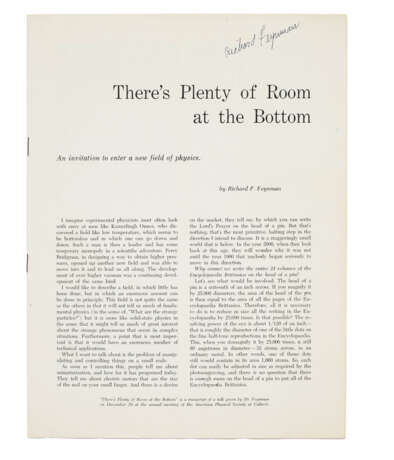ID 1105582
Lot 63 | FEYNMAN, Richard Phillips (1918-1988)
Estimate value
£ 25 000 – 35 000
‘There’s Plenty of Room at the Bottom. An invitation to enter a new field of physics’. Offprint from: Engineering and Science Magazine. Pasadena, CA: California Institute of Technology, February 1960.
First edition, exceptionally rare offprint, signed by Feynman, of this visionary lecture which represents the birth of nanotechnology, the field of applied science involving manipulating matter on an atomic and molecular scale: ‘What I want to talk about is the problem of manipulating and controlling things on a small scale.’ The present lot is the first published version of an after-dinner lecture Feynman delivered at the annual meeting of the American Physical Society in December 1959. ‘The banquet speech would prove prescient. Feynman’s lecture is widely accepted as spurring the field of nanotechnology, and the Nobel Prize Committee lauded it as “visionary” when they awarded the 2016 Nobel Prize in Chemistry to researchers who assembled tiny motors made of molecules’ (Kornei). Years before the term nanotechnology would be coined, Feynman laid out the principal problems and potentials of the field. He noted, ‘I will not discuss how we are going to do it, but only that it is possible in principle – in other words what is possible according to the laws of physics.’ Feynman considered the possibility of direct manipulation of individual atoms as a more powerful form of synthetic chemistry than those used at the time, laying out challenge after challenge: reducing the Encyclopedia Britannica to a pinhead, making an electron microscope that could see individual atoms, building a microscopic computer, and even ‘swallowing the doctor’ – building a tiny, ingestible surgical robot. In an era when computers filled entire rooms, what Feynman proposed seemed nearly unfathomable: ‘I am not afraid to consider the final question as to whether, ultimately – in the great future – we can arrange atoms the way we want; all the way down!’ Although versions of the talk were reprinted in a few popular magazines, it went largely unnoticed at the time (it was cited only seven times in the two decades following its publication). Beginning in the 1980s, however, nanotechnology advocates cited it to establish the scientific credibility of their work. Many of Feynman’s ideas have been explored and some have been realized, and nanotechnology holds the promise of revolutionizing industry and medicine. Extremely rare: we have not been able to trace another copy at auction (RBH) or on the market, and we have been unable to trace any other copies in institutions. Katherine Kornei, The Beginning of Nanotechnology at the 1959 APS Meeting, APS News, November 2016 (aps.org/publications/apsnews/201611/nanotechnology.cfm).
Quarto (296 x 223 mm). Pp. [8]. Stapled self-wrappers as issued (very small patch of adhesion on imprint on verso of final leaf, some very faint and insignificant creasing). Provenance: authorial inscription in biro in top margin of first page.
| Address of auction |
CHRISTIE'S 8 King Street, St. James's SW1Y 6QT London United Kingdom | ||||
|---|---|---|---|---|---|
| Preview |
| ||||
| Phone | +44 (0)20 7839 9060 | ||||
| Buyer Premium | see on Website | ||||
| Conditions of purchase | Conditions of purchase |



